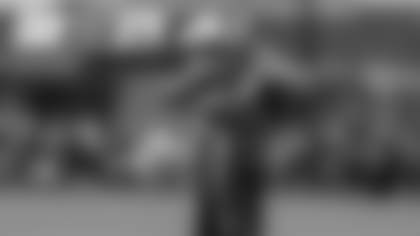Leo from Metairie, LA
Dimitrius Underwood was a first-rounder cut during training camp, although it wasn't for talent reasons.
Technically you're right, but I'd rather put Underwood into a special category.
Rob from Rock Falls, IL
I have noticed in recent years that (with most teams) the fullback position is disappearing fast and that tight ends are no longer simply a smaller lineman with ball skills. In fact, tight ends are quickly becoming many quarterbacks' favorite targets. What do you think has inspired this change?
It's part of the evolution of the game. Head coaches and offensive coordinators are big on avoiding negative plays (sacks) and maintaining a high completion percentage. By dumping the ball or checking it down to a safety-valve type of receiver, the quarterback can avoid sacks and improve his completion percentage. A pass-catching type of tight end is a big, good-hands, check-down type of receiver that also offers coaches and coordinators the ability to create mismatches, especially if you get a defense in nickel. When that happens, you've got more beef up front than the defense has and you should be able to run the ball. The tight end is the player with which a good offensive mind can pencil-whip his defensive counterpart. Tom Moore did it for a lot of years in Indianapolis with Dallas Clark and I can see Mike McCarthy doing the same things with the return of Jermichael Finley and the addition of D.J. Williams.
John from Madison, WI
Vic, I strongly disagree with your answer in regards to the Giants, Patriots Super Bowl. Nine times out of 10 the Patriots win that game, because they truly were the best team in the NFL that year. The fact that the Giants won is one thing that is wonderful about the NFL, that on any given Sunday any team can overcome all odds and be victorious. Was the Steelers team that beat the Seahawks the best in the NFL? No, they were an above-average team that got on a hot streak at the end. The Cardinals are another example of this, as well.
So, getting hot at the end of the year, after having played a brutally difficult regular-season schedule, and then winning on the road in three consecutive playoff games, which included wins at the No. 1- and No. 2-seeded teams, doesn't count? That didn't prove anything? The Giants didn't prove their mettle by nearly spoiling the Patriots' undefeated season at the end of the regular season, and then going on the road and winning in the cold in Green Bay and then beating the Patriots in the Super Bowl in the second meeting in a month between the two teams? Didn't those two teams kind of take the same route to the Super Bowl the Packers did last season? Are you sure you're being objective? I'll tell you this, when teams do what the 2005 Steelers, '07 Giants and '10 Packers did, I think they deserve to be called "the best," and that's exactly what I'll call them. What the Packers did last season was extraordinary, and it was eerily similar to what those other two teams did. By the way, all three of those teams played rugged regular-season schedules. That's what earns my respect.
Merle from Farmington, IL
Why do they still walk the chains out to measure for first downs? They could easily put a laser on the sideline stick that would send a perfectly straight line across the field and give an accurate reading in one-twentieth of the time.
Or they could do it by GPS and have the game officiated from outer space. What would Coach Lombardi think about all of this talk?
Shannon from North Little Rock, AR
When an opposing team signs a practice-squad player and has to place that player on the team's active roster, is there a minimum number of games that player has to be active or can they deactivate them to their own practice squad after the next game?
The player doesn't have to be on the game-day active 45, but he must be on the team's 53-man roster for a minimum of three weeks. At that point, the player can be cut and signed to the practice squad. Don't think in terms of moving players to the practice squad. Practice-squad players are free agents. You own no rights to a player on your practice squad.
Travis from Orlando, FL
So, basically you're of the mindset that to be the best team that year you just need to be the best team in your final four games (playoffs), correct? The 2007 Giants team that beat the Patriots was a .500 team for the final eight weeks of the season, yet, they're the best team?
Yes, I would say that. It's all about crunch time. That's when the best teams and the best quarterbacks get it done. The postseason is the ultimate crunch time. Just win, baby.
John from Casablanca, Morocco
I read the story about the "Tailgate Tour" and was surprised that it included current players Flynn, Bishop and Sitton. Did the Packers have to get special permission to include them on the tour in light of the lockout?
Special permission was granted because the "Tailgate Tour" is a team charity event.
Nick from Jacksonville, FL
Is the ball used in the NFL bigger than that used in college football? That's what it looks like on TV. If so, isn't that a significant issue for quarterbacks transitioning from college to the NFL?
This is a difficult question to answer because college football uses several different models of footballs. Let's use the most popular model in comparison to the NFL ball. I'm talking about the Wilson GST, which is the most used ball in college football. There are actually a few versions of the GST, but the most-used version is slightly fatter than the NFL ball, which would normally make it a little more difficult to grip and throw, but the GST most used by college teams has a raised pebble-grain finish and grip-friendly laces that allow for a smaller hand to get a better grip on the ball, especially in cold and wet weather. The college ball also has stripes at each end, but they also include a tacky, raised finish that aids in gripping the ball. The NFL ball might be a little skinnier – length is either the same or about the same – but it gets slick and a small-handed quarterback can soap-dish the ball in cold or wet weather. Be that as it may, Dan Marino had small hands and he didn't seem to have any trouble throwing either ball.
Tom from Gas City, IN
I have a Packers NFL legends autographed football that was made by a company that no longer is listed and I would like to have this collectible restored. It has leaked out its air and I would like to get it repaired. It is one with signings of Starr, Hornung, Nitschke, Taylor. If you have any ideas on how to save my piece of Packers history, I would appreciate it.
If I had something with those names on it, I wouldn't do anything to it until I talked to an expert in the field of collectibles. That's my advice; find a collectibles expert. In my mind, however, you also have to ask yourself this question: What is the ball worth to me? If it's about the heart, then approach restoration that way.
John from Austin, TX
It's interesting that you brought up Tom Coughlin as having zero tolerance for fumbling. His offenses have featured two of the biggest fumblers in recent memory: Ahmad Bradshaw last year and Tiki Barber a few years back. I think that there is zero tolerance if the back can be replaced with someone else just as talented. Otherwise, there seems to be some amount of patience while the coaches and player work on improving technique.
I brought up Coughlin because he is famous for a particular quote on the subject of fumbling. When he would address the media about a player having fumbled, Coughlin would often refer to "a callous disregard for the ball," and it always brought a chuckle. You're right, the better a player is, the more likely a coach is to live with that player's fumbles. Adrian Peterson is the perfect example from the 2009 NFC title game. Most backs, however, don't possess Peterson's talent, so it would serve their career best that they not fumble too often, or at all. Coughlin cut a guy, a draft pick in the Jaguars' expansion year, because he was a fumbler.
John from Green Bay, WI
I received one of those mass e-mails about the Packers. It said the Packers are a small-market team, but then went on to explain that they have a huge fan base; lots of people watch them at the stadium and at home on TV and they sell tons of merchandise. Besides the size of Green Bay, what makes the Packers a small-market team?
Market size is the only factor in defining a team as a big or small-market team. It's incredible to think that you could put the entire population of Green Bay into Michigan Stadium or Beaver Stadium and still have room for the bands, real big bands. The Packers' popularity is built on the town's smallness; I truly believe that. Those Packers fans that aren't from Wisconsin and don't have ties to the region, and there are millions of those types of Packers fans worldwide, became fans of the team as a result of the team's tradition, the fame of Vince Lombardi and, I believe, because they were attracted by the charm of a small town in a league of big cities. Hey, it's what attracts me. I like it. The big-small thing is intriguing. Let me put it this way: It gives the Packers a true identity, and that's what drives popularity.














